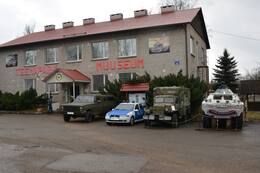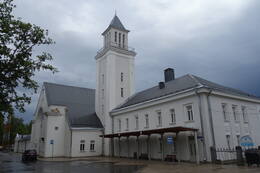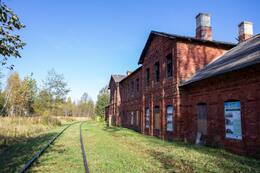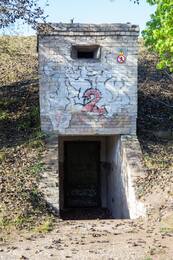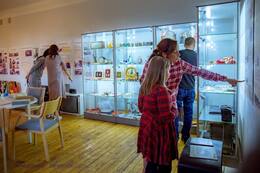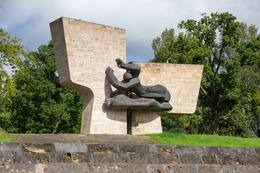Sovietinės okupacijos paveldas Šiaurės Vidžemėje ir Pietų Estijoje
Diena 4.
255 km
Tartu–Valga–Seda–Valmiera–Rīga
Praktinė informacija
- Driving distance: 255 km
- Due to distances and time, 4 of the listed sights can be visited on this day.
- Opening hours and ticket information for Valga Military Theme Park www.isamaalinemuuseum.ee. Guided group visits should be booked in advance. For the most exciting experience, using the guide services is highly recommended.
- The Defence line “Walk” near Valga is only possible for groups and with advance reservation combined with the visit of Valga military theme park.
- Those interested in experiencing a military atmosphere, can book accommodation in Valga military theme park.
- Underground Military bunkers in Valka are viewable from outside only.
- The visit to Seda House of Culture by prior booking +371 29436275.
- Valmiera audio guide and tourist information visit.valmiera.lv. Audio guide is available in Latvian, English, Russian, German, Estonian languages.
Lankytinos vietos
Valgos karo muziejus – tematinis parkas
This museum and theme park showcases the internal security and military history of Valga and Estonia. The place is perfect for organising summer camps with field activities and a field trip to a World War II battle site near the Väike-Emajõgi River. The programme includes learning to cook pea soup (a popular dish in the military), using camouflage face paints and orienteering in the woods.
The exhibition at the theme park includes military equipment, artillery, an Mi-8 helicopter, a fire engine and various types of machine gun pillbox and naval mine. The tour ends at a Forest Brothers’ bunker, where, on prior request, an alcoholic beverage drunk by the Forest Brothers and smoked lard sandwiches with onion are served. For more serious enthusiasts, the museum displays the largest collection of weapons in Estonia. The Estonian Defence Forces, Police and Border Guard Board, Defence League and Internal Security Service organise demonstrations at the museum of the duties they carry out. They are joined in doing so by the Latvian Police, Border Guard and Fire and Rescue Services.
Valga railway station built by German prisoners of war
The main building of Valga railway station (Leningrad Transport Planning Office, architect: Viktor Tsipulin) was completed in 1949. It is an elongated two-storey structure with an avant-corps and a hipped roof, its architectural showpiece being its seven-storey square tower. It is one of the best and most remarkable examples of Stalinist architecture in Estonia. Its original state having been so well preserved further elevates its significance. The railway station was built shortly after World War II in place of a building from the imperial era that Soviet bombing had razed to the ground. Since German prisoners of war were detained in Valga, it is plausible that they were used to construct it.
Valka train station
The Valka Railway Station is located at the end of Poruka street, next to a set of train tracks that are out of use. The station building can only be viewed from the outside where information stands of the importance of the railway in Valka and Valga are in place. Near the station building is a memorial stone devoted to the people deported to Siberia on 14 June 1941. The station building was constructed around 1896-1897. Narrow-gauge railway lines in the Valka-Rūjiena-Pärnu section were put in place here initially. During World War I, the railway was severely damaged. After establishing the state border, the Valka Railway Station (Valka II) became a border station. In late September 1920, the special Railway Board Commission arrived in Valka. The commission was authorised to negotiate and conclude an agreement with Estonia on the transfer of passengers from the station of one state to the other. The tracks between the triangularly placed Lugaži, Valka and Valga stations were strategically important, as they allowed armoured trains to turn around and move in the opposite direction. During the Soviet period, the USSR Army used this station to deliver ballistic missiles to Valka. A mass deportation of the Latvian people to the inland areas of the USSR took place on the night of 13-14 June 1941. More than 90 people from Valka and the surrounding areas were put in cattle waggons to be deported from the Valka Railway Station without any court judgement, prior warning or explanations. In September 1944, the station was destroyed by the retreating German Army.
Požeminiai bunkeriai Valkoje
The Valka bunkers are located in the centre of the city of Valka, on the left side of Ausekļa street, next to the Ādams Tērauds School. Visitors can only view the bunkers from the outside. The Soviet Army bunkers in Valka were among the most secret places in Soviet Latvia only accessible to people with special permits. From 1953 to 1989, they were home to the Soviet Army’s strategic missile communications reserve. Large 16 wheelers were used to deliver massive reinforced concrete blocks for building the bunkers. Once completed, all three bunkers were covered with gravel for additional reinforcement and insulation. The bunkers housed a strategic missile communications reserve subordinated to the Leningrad Communications Centre. Silos with army missiles were controlled from these bunkers. There were 20 such silos in the Valka and Valga area. In October 1962, during the Cuban Missile Crisis, these missiles were combat-ready and aimed at Florida. Legend has it that they were a couple of hours shy from actually being launched. Right next to the Ādams Tērauds School and the underground bunkers is the Swedish (Sheremetyevo) Fortification. The artificial wall of earth was built at the beginning of the Great Northern War, around 1702, to protect Valka against the Swedes. The steepest wall of the fortification faces the village of Ērģeme, while the other side faces Ausekļa street.
Seda cultural heritage (1953-1990) exposition and Stalinist architecture
The town of Seda was originally built as a workers’ village, together with the construction of a peat factory in 1953. The peat factory was declared part of the All-Union Komsomol Shock Construction Project, with young people from all over the Soviet Union coming here. This defined the character and face of the village. In 1954, Seda was granted workers’ village rights. In 1961, the workers’ village was named a township. On 14 November 1991, the township with a rural area acquired the status of the town of Seda with a rural area. An exhibit of cultural and historical heritage is on display at the Seda Culture House. The panels in the exhibition hall showcase the history of development of the Seda area, starting from the historical period when the Salānieši farm property extended across the territory of the town of Seda to the construction of the town. The exhibit features stories about the reasons for and process of the creation of the town, the history of the Seda Peat Factory and other documentary evidence. In terms of core content, the exhibit mainly includes historical archive materials: protocols, decisions and orders. To help visitors gain a better sense of this period of history, the exhibit includes a ‘manager’s office’ featuring items from that time. The exhibit is also visually enhanced by Soviet-era household items that are on display in addition to different documentary evidence.
Valmiera
Valmiera vēstures avotos pirmo reizi minēta 1323. g. Līdz 13. gs. šī vieta atradās latgaļu apdzīvotajā Tālavā. Valmieras viduslaiku pils celtniecība tika uzsākta 13. gs. sākumā, bet 1283. g. starp Gauju un Rātes upi sāka slieties baznīca. Apdzīvotās vietas ekonomisko attīstību sekmēja atrašanās pie Pleskavas un Tērbatas-Novgorodas tirdzniecības ceļiem. 14.- 16. gs. Valmiera ietilpa Hanzas savienībā. Tā ievērojami cieta no 16.-18. gs. kariem, epidēmijām un ugunsgrēkiem. 19. gs. otrajā pusē atkal sākās pilsētas saimnieciskais uzplaukums. To sekmēja arī 1866. g. uzbūvētais koka tilts pār Gauju un 1899. g. atklātais Rīgas-Pleskavas dzelzceļš. 1944. g. tiek sagrauts pilsētas vēsturiskais centrs. Pēckara gados pilsētā funkcionē lieli rūpniecības uzņēmumi, piemēram, - Valmieras stikla šķiedras rūpnīca (arī mūsdienās). Mūsdienās Valmiera ir Vidzemes ekonomiskais, izglītības un sporta centrs.
Memorial to the soldiers fallen in World War II
The memorial ensemble in Valmiera was unveiled in 1985. World War II Soviet soldiers who fell in the vicinity of Valmiera and victims of Nazi terror have been reburied in the Brothers’ Cemetery. The authors of the memorial ensemble are sculptors Zigrīda Rapa and Juris Rapa, architects Ēvalds Fogelis, Jānis Lejnieks, Jānis Rutkis and Andris Vītols, and Design Engineer Ivars Veldrums. Limestone from the village of Allaži was used to decorate the memorial ensemble. Its main image is the split linden tree of the Coat of Arms of Valmiera city. Two sculptures on each side of the ensemble symbolise the rhythm of life and death. The figures facing the Gauja river form a semi-circular space, marking the boundary between the past and the present. The main image facing the city is part of an intense arch-shaped form. The figure of a soldier faces the visitors approaching from the side of the city by the bridge, with the diagonal shape formed by the soldier’s hand supporting his deceased companion. On the burial terrace, soldiers have been laid down in rows for those who fought shoulder to shoulder in battle to lie under the same turf. A composition named the Golden Apple Tree lies separately on the lower terrace of the memorial. A granite plaque commemorates the Jews reburied here. Some of the elements, including bronze apples with the ensemble’s message encrypted by the authors, which had been placed under the growing apple tree, disappeared in the 1990s. A QR code next to the memorial gives visitors access to an audio guide with the information available in Latvian, Russian, English, Estonian and German.
Vietos pavalgyti
Bistro Sinel
Bistro Sinel is located in the yard of Valga Military Theme Park, offers a delicious lunch at an affordable price. Enjoy a refreshing steak with fresh salad, a lovely bowl of soup, or a nice smoothie in the summer – there is a different menu every day!
You can also ask us to set the table for you.
In Valka / Valga visit.valka.lv/en/taste/catering–in–valka; visit.valka.lv/en/taste/catering–in–valga
In Strenči strencunovads.lv/turisms
In Valmiera visit.valmiera.lv/lv/kur_paest




